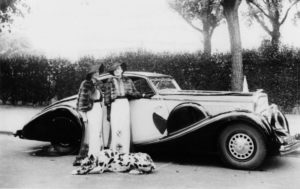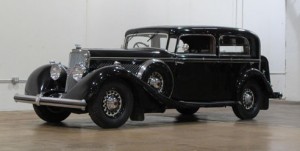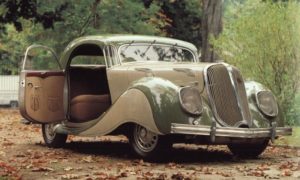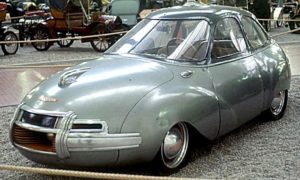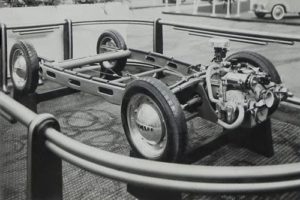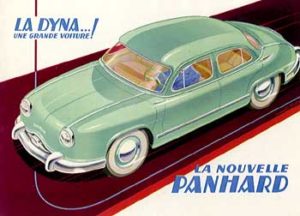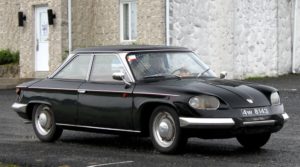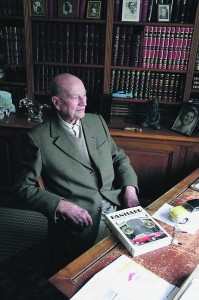We are sad to announce the death of Jean Panhard on Tuesday July 15. He was 101 years of age. Jean Panhard, was a privileged witness to a very large part of automotive history.
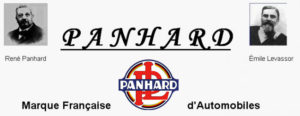
Panhard et Levassor was the world’s first commercial manufacturer of automobiles, selling 21 cars in 1891.
Eldest son of Paul and Louise Panhard Bonnel, Jean Panhard was born in Paris on June 12, 1913. His father Paul undertook daily management of the Panhard & Levassor company in the tying times of the great depression. Panhard & Levassor built quality vehicles, but their high price meant that they were purchased by a relatively wealthy clientele. In addition to automobiles the Panhard & Levassor factory produced trucks, military vehicles, gasifiers and woodworking machines…
During the 1920’s Jean Panhard continued his studies staying focused on the automotive world! After a solid training at Polytechnique in 1933, he completed his military service at the School of Artillery under Fontainebleau. These years of study tutorship by his father allowed him to forge friendships and get to know many people active in the world of industry and business. On November 18, 1937, with Panhard & Levassor’s situation anything but thriving, he began his career with the company. He rose to become head of SAAE Panhard et Levassor until its demise and takeover by Citroën in 1967.
Known for its flamboyant vehicles such as the Panhard Dymanic in the 1930’s, economic conditions post WWII forced Panhard to produce more affordable cars. The company was renamed Panhard (without “Levassor”), and produced light cars. But not without flair, as the “aviation” styling of the Dynavia’s droplet bodywork made waves when the prototype was presented by Panhard at the Paris Motor Show in 1946.
1946 also saw the the birth of the Dyna twin engine, the basis of all Panhard automobile production from that point onward. Cars such as; the Dyna X, Junior, Dyna Z, PL 17 and ultimately the Panhard 24 (named for the 24 Hours of Le Mans).
The company had long noted the weight advantages of aluminum, and this as well as postwar government steel rationing (designed to limit new car models to ensure an orderly return to production at the major firms), encouraged the firm to proceed with the expensive alternative of making the bodies and several other components out of aluminum. The Dyna 54, Dyna X and early Dyna Z series 1 had aluminum bodies.
Unfortunately, cost calculations by Jean Panhard, now managing director of the firm, failed to account fully for all of the extra cost of aluminum vs steel, as his calculations were made for the sheet metal panel area actually utilized per body shell, and erroneously did not account for the cut offs and scrap of each of the stampings making up the shell. Once in production, a re-examination cost analysis showed a cost of 55,700fr for aluminum shells and only 15,600fr for steel. The use of aluminum had pushed the firm perilously close to bankruptcy, so much so that in 1955 he was forced to sign an agreement with Citroën that would end ten years later in a merger of the two brands.
Under Citroën a rush engineering job saw the firm return to steel. Thus, the later Dyna Z (from mid September 1955) and the successor PL 17 bodies were steel, and the major stampings retained the heavier gauge intended for durability with aluminum, so as to avoid complete replacement of the stamping dies.
Under Citroën, Jean Panhard fought to prolong the life of the Dyna to become PL 17 in 1959 and to study a new model, the 24, a two door coupe with a body of astonishing modernity.
Alas, at the end of the summer of 1967 Citroën took control of Panhard, ending their passenger production but allowing Jean Panhard to develop a military department via SCMPL (Company Panhard & Levassor mechanical engineering) which he was president and CEO until his retirement in 1982.
Jean Panhard held several important posts in the same era:
• President of the Organizing Committee of the Salon de l’Automobile, Motorcycle and Cycle (1967-1978)
• President of the Salon de l’Automobile (up until 1988)
• President of the Chambre Syndicale of automakers (1979-1982)
• President of the Regional Chamber of commerce and Industry of Paris (1974-1980)
He also performed many functions with the Chamber of commerce and Industry in France and at the European level or the Executive Board of the National Council of French Employers in the 70s and 80s. With the creation of Equip’Auto Salon in 1975, he was also President of the Automobile Club France (ACF) from 1977 to 1989 and served as vice-president of the International Automobile Federation (FIA). During the seventies, he became interested in automotive heritage and worked to rescue the vehicle collection assembled by the Schlumpf brothers which became basis for the creation of the National Automobile Museum, whose fame is now global. This activity also leads him to create in 1986 the Association of Automobile Museums of France (AMAF), then in 1987 to stimulate the creation of a Federation of Panhard & Levassor Clubs.
In June 2013, while celebrating his centenary, Jean Panhard was honoured by the Federation of Panhard & Levassor Clubs, who thanked him for everything he did over the years, both for the automotive world and all the “Panhardistes”, who continue to preserve and enjoy his wonderful cars!
A funeral service will be held Friday, July 18 at 10 am in the Notre Dame de Crécy Chapel (Seine et Marne).

